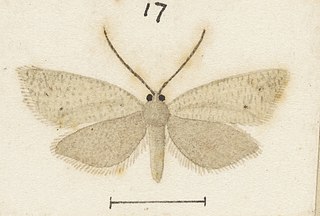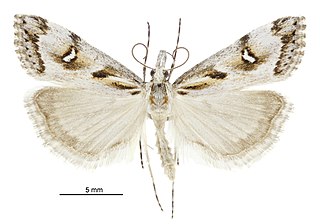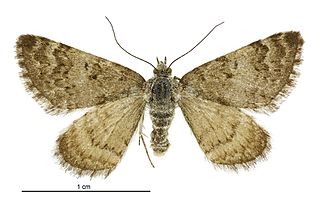
Thectophila is a genus of moths in the family Cosmopterigidae, although some sources place it in the family Blastodacnidae. The genus contains only one species, Thectophila acmotypa. This species is endemic to New Zealand. It is classified as "Data Deficient" by the Department of Conservation.

Austrocidaria parora is a species of moth of the family Geometridae. It is endemic to New Zealand.

Stigmella progama is a species of moth in the family Nepticulidae. This species is endemic to New Zealand and has only been collected on Bold Peak in the Humboldt Mountains. Larvae are leaf miners although their larval host plant has yet to be determined. It is classified as "Data Deficient" by the Department of Conservation. S. progama has only been collected on Bold Peak, in the Humboldt Ranges, in Otago.

Izatha psychra is a species of moth in the family Oecophoridae. It is endemic to New Zealand. It is classified as Nationally Endangered by the Department of Conservation. In 2020 it was feared that this moth was extinct as a result of a fire at the Pukaki Scientific Reserve, the last known locality of this species. However a 2021 survey found I. psychra present in the small portion of the reserve that was not damaged by the fire.

Circoxena ditrocha is a species of moth in the family Blastodacnidae. This species is endemic to New Zealand and has been collected on both the North and South Islands. The habitat of this species is on the edges of native forest or scrub and it may be associated with Pseudopanax arboreus. As of 2000 the host species of this moth is unknown but it has been hypothesised that the larvae are seed borers. Adults are on the wing in December to March. It is classified as "At Risk, Naturally Uncommon" by the Department of Conservation.

Ichneutica blenheimensis is a species of moth in the family Noctuidae. It is endemic to New Zealand and is found throughout the North, South and the Stewart Islands. This species appears to prefer drier eastern localities and is rarely collected in western North Island forested areas. It does not appear to be frequently collected in inland dry tussock grassland habitats. The host plant for the larvae of this species is likely to be the golden sand sedge pīngao which is now absent from the moths type locality. However Chappell has raised very young larvae on grass species and the more developed larvae consumed Phormium tenax. Adults are on the wing from November to March and are attracted to both light and sugar traps. The blackish forewing fringes are diagnostic of this species. But worn specimens of I. arotis can be confused with worn specimens of I. blenheimensis. However I. arotis can be distinguished from I. blenheimensis as it has a scale-tuft on the thorax and dark longitudinal stripes on the tegula. This species is classified as "At Risk, Naturally Uncommon" by the Department of Conservation.

Chersadaula ochrogastra is a species of moth in the family Oecophoridae. This species is endemic to New Zealand. It is classified as "Data Deficient" by the Department of Conservation.

Ericodesma aerodana is a species of moth of the family Tortricidae. It is endemic to New Zealand and is found in the North and South Islands. The species inhabits sand dunes and larvae feed on Pimelea prostrata. Adults are on the wing from October to January and are active at twilight. This species is classified as "At Risk, Declining" by the Department of Conservation as its larval host plant is under threat from habitat loss and the invasive to New Zealand plant, sea spurge.

Eurythecta robusta is a species of moth in the family Tortricidae. This species is endemic to New Zealand. It is classified as "At Risk, Naturally Uncommon" by the Department of Conservation.

Gadira leucophthalma, the beaked moss moth, is a moth in the family Crambidae. It is endemic to New Zealand. It is found in the south eastern side of the South Island down to Banks Peninsula. G. leucophthalma inhabits the foredunes of coastal areas. The larval host is unknown but it has been hypothesised that the larvae feed on moss. The adult moths are day flying although some specimens have been trapped at night via light traps. Adults are commonly on the wing from March to April. This species has been classified as Nationally Vulnerable by the Department of Conservation.

Glaucocharis elaina is a species of moth in the family Crambidae. This species was described by Edward Meyrick in 1882. It is endemic to New Zealand and is found throughout the North and South Island with the exception of the extreme south of the South Island. The preferred habitat of this species is lowland native forest and as adults the species is attracted to broken ground including road or rail cuttings. Larvae feed on moss species including those in the genus Funaria. This species has two distinct broods during each year. Adults are on the wing from October to April, are nocturnal and are attracted to light.

Glaucocharis auriscriptella, also known as the yellow silverling or silver marked yellow, is a moth in the family Crambidae. It was first described by Francis Walker in 1864 and is endemic to New Zealand. This species can be found in the North, South, Stewart and Great Barrier Islands. The preferred habitat of this moth is lowland and subalpine native forest as well as wetlands. The larvae feed on moss. The adult moth is day flying and is on the wing from November to February. It can be observed in colonies and can be attracted to light at night. This species likely has only one generation per year.
Kiwaia jeanae, also known as the Kaitorete jumper or mat daisy jumper, is a species of moth in the family Gelechiidae. It is endemic to New Zealand. This species is classified as "At Risk, Naturally Uncommon" by the Department of Conservation. Both the males and females of this species are brachypterous.

Xanthorhoe orophyla is a moth of the family Geometridae. It is endemic to New Zealand and is found in the South Island in alpine habitat. This species has one brood a year and their larvae feed on cruciferous plants. Adults are on the wing from December to February and are attracted to light.

Asaphodes imperfecta is a moth in the family Geometridae. It is endemic to New Zealand and is found in the southern part of the South Island. The species inhabits low lying swampy native forest. The host plants of the larvae of this species is unknown. The adults are on the wing in December and January. It is classified as critically endangered by the Department of Conservation.

Orocrambus sophistes is a moth in the family Crambidae. This species is endemic to New Zealand and has been observed in South Island at the Mackenzie Basin, Central Otago and Otago Lakes areas. This moth is a dryland specialist and inhabits short tussock grasslands. The larval host species is Festuca novae-zelandiae. The adults of this species have been observed from mid January to April with the female being flightless. The adult male is attracted to light. This species has been classified as Nationally Vulnerable by the Department of Conservation.

Paranotoreas fulva is a species of moth in the family Geometridae. This species is endemic to New Zealand and is found in the southern half of the South Island. The preferred habitat of this species are the salt pans of Otago, the mountainous grassland areas in South Canterbury and Otago and the glacial outwash terraces south of Tekapo. The larvae feed on Atriplex buchananii and Plantago coronopus. Adults are day flying and have been recorded as being on the wing in March, October and December. P. fulva is classified as "At Risk, Relict" by the Department of Conservation.

Dasyuris enysii is a species of moth in the family Geometridae. It is endemic to New Zealand. This moth is classified as "At Risk, Naturally Uncommon" by the Department of Conservation.

Xanthorhoe lophogramma is a species of moth in the family Geometridae. It is endemic to New Zealand and if found in the South Island. This species inhabits dry beech scrub but its larval host is unknown. Adult moths are on the wing in January. This species is classified as "At Risk, Nationally Uncommon" by the Department of Conservation.

Euxoa ceropachoides, commonly known as Fereday's cutworm, is a species of moth in the family Noctuidae. It is endemic to New Zealand. It is classified as Not Threatened by the Department of Conservation.






















